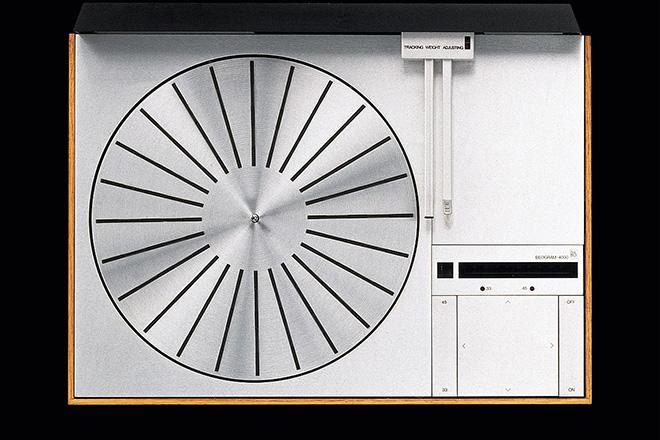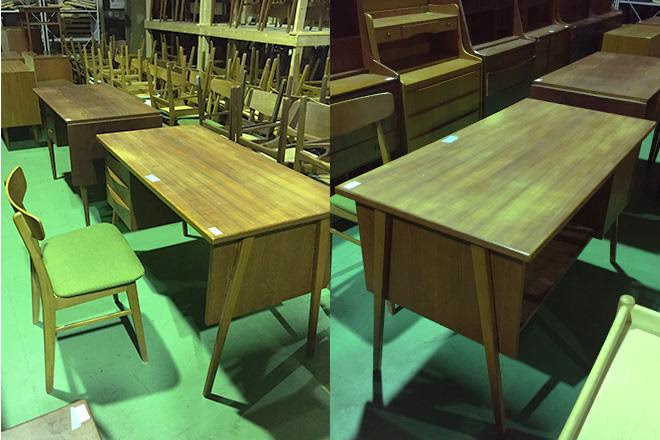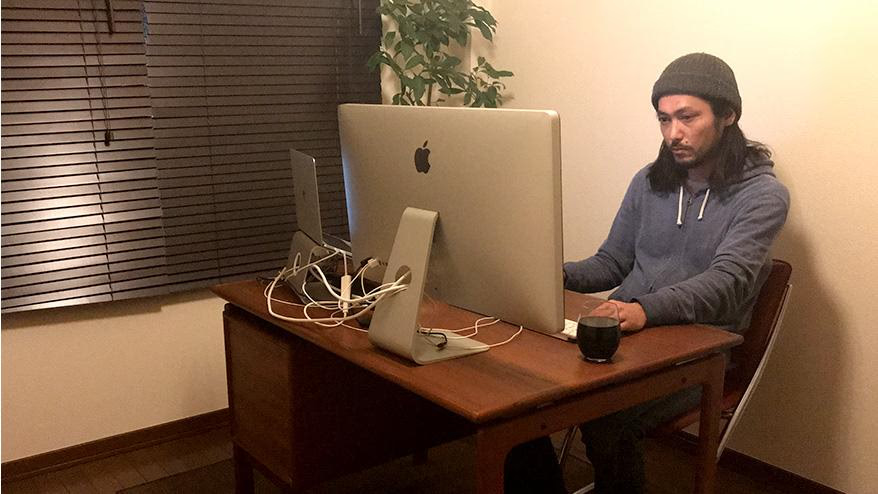Hello, this is Shizuha from the design department.
Following on from yesterday, I would like to introduce you to Denmark, a country overflowing with wonderful designs from architecture to furniture, tableware, and more, and why it has such a fascinating culture that it is known as a design powerhouse.
In the first part, we introduced the country of Denmark, outlined the "Danish Design" exhibition, and introduced some of the important designers featured there.
In the second part, I would like to introduce why these designs continue to be loved, the desk I actually purchased, and what I have learned through Danish design.
Why Danish design continues to be loved
The Danish master designers introduced in the first part did not suddenly create new values in Denmark. As in other European countries, after the Industrial Revolution at the end of the 18th century, the public's values regarding everything, including art, architecture, philosophy, and science, changed dramatically. In the midst of this trend, the Great Exhibition in London was held in 1851 as a celebration of modern industrial technology and design, and immediately afterwards, many art and craft museums were established all over Europe. The aim was to raise awareness of aesthetic values regarding quality by collecting excellent items from all eras and cultures in museums, and to encourage companies to develop excellent products.
However, as modernism began to take hold in the 20th century, people began to liquidate traditions, and the value of "not looking back at the past" became mainstream, and the future envisioned by society as a whole began to place emphasis on technology. In Denmark, too, under the influence of the German Bauhaus, functional and rationally produced furniture and products by manufacturers mainly engaged in industrial production flowed in, and concerns spread that traditional craftsmanship would be threatened.
So Danish furniture craftsmen decided to hold an exhibition called the "Furniture Manufacturers' Union Exhibition." At the exhibition, manufacturers and furniture designers presented a series of products that were jointly created, and a design contest was also held at the same time, which led to the development of a unique sense of value that is characteristic of Denmark as well as improving quality. Denmark, where many designers have a background as artisans, has a foundation of craftsmanship, including superb assembly using natural materials that are pleasant to the touch and appeal to the senses, well-thought-out design, and simple structure. Even in an era when machine production became mainstream, Denmark has succeeded in retaining the nostalgic warmth of handcraft in its products, something that other countries could not achieve.
Kaare Klint, who was introduced earlier, moved the Royal Academy of Fine Arts into the museum in 1924 and established a furniture department in the academy's Department of Architecture. He taught his students that "things must be designed to suit the purpose for which they are to be used," and he studied every detail diligently, using artefacts from the museum's collection as samples and taking measurements of old furniture and tools from different cultures. These efforts formed the core of mid-century Danish furniture design.
Danish design is recognised as special and unique because it is a unique design culture based on the study of other eras and different cultural typologies and forms. The designs, which have been described as "simple," "modest," and "calm," are sophisticated and functional, and not only do they give off a modern impression, but they also have an indescribable warmth that makes use of the characteristics of the materials, which may be what gives them their special charm.
After this golden age, interest in Danish design abroad began to gradually wane in the 1970s. However, the functional and modernist tradition continued unchanged, as seen in the audio designs for Bang & Olufsen by Jacob Jensen ( 1926-2015), a world-renowned Danish product designer. Many of the disciples of the masters from the 1930s to 1950s took over the designs based on simple and new ideas that suited the times, and there were many masters who attracted attention again, and designers who attracted attention with their new ideas for designs.

The stylishly designed record player "BANG & OLUFSEN - BEOGRAM 4000 (1972-1975)" was designed by Jacob Jensen.
(Photo by Wikipedia – Change of venue(2017) / Adapted.(CC BY-SA 4.0))
Then, around the turn of the 21st century, the world's attention on Denmark has been rekindled. The works of new manufacturers and designers have revived the market with products that still retain the mindset of respecting tradition. In addition, vintage items from over 70 years ago are now being traded at high prices at auctions, and it is clear that the value of Denmark is being recognized once again.
In developed countries, the values of the half century since the 1950s, when mass production and mass consumption were considered a symbol of wealth, have shifted to a trend in values that aim for a sustainable society that is environmentally conscious, such as organic and ecology, which has spread in the early 21st century. This change in the public mood towards "good things in only as much as you need" is likely causing people to once again focus on the "special value that is timeless" of Danish design.
I want Danish furniture.
With Danish design once again in the spotlight, I, who have a soft spot for old things, have had a fresh desire to acquire some of the furniture from that time. This wish came true when I moved house in May of this year, which led me to visit the design exhibition and start writing this article.
Until then, I had been using a George Nelson bench as a low table for my PC desk, but long hours of work were tiring on my body, and since I would have my own room in my new home, I first thought about replacing it with a desk where I could sit on a chair. I wanted a desk wide enough to place my Macbook Pro and the 27-inch monitor connected to it side by side, and a palm rest in front of the keyboard with enough space to write by hand. That meant I needed something quite large.
I thought about buying something simple like an affordable office desk, or doing a DIY project at a hardware store. However, moving is a big event, and I was excited, so I wanted to take this opportunity to get something I could use for a long time, so I first looked at a few online shops that sell vintage Scandinavian furniture.
The desks on display come in a wide variety of materials, sizes, and designs, but the right size is popular, so there is a low stock, which is disappointing. As I compared the desks, I wanted to see the real thing, so I went to a Scandinavian furniture specialty store in Isehara, Kanagawa, and a furniture specialty store along Meguro-dori in Tokyo, and continued my search for the perfect desk.

In the back yard of a Scandinavian furniture store in Isehara, Kanagawa Prefecture, we were shown furniture such as desks before they were repaired.
All the furniture in the specialty store has been perfectly restored and given new life, and the vibrant luster of the wood grain makes it shine, so you can never get bored of looking at it. My imagination was pushed to the limit, and I was able to spend a meaningful time.
Finally got my hands on a Danish desk
After actually looking at it in the store, I got a clearer idea of what I wanted, but compared to shelves, tables, chairs, and sofas, there were only a few stores that sold desks, and there was only one desk that I could choose from. I wanted more options, so I started to think that I would have to rely on online shops, but then I remembered an auction site and took a look.
Most of the items were professional listings from furniture specialty stores. The photos and explanations were easy to understand, but the prices were no different from those of online shops, and there was no advantage to buying at an auction. I waited for a few days, hoping that if I was lucky, I would be able to find something that was suitable for my new home in terms of design, condition, and size among the few private listings. Then, I found a suitable listing and was able to win the bid at an exceptional price.
A few days later, I received the actual item safely from the delivery company via furniture delivery service, and when I opened it and touched it, I was surprised at how heavy the teak wood was, much heavier than I had expected. It was so heavy that it was difficult to carry it by myself. Furthermore, it would not fit through the entrance to my room as it was, so I tried turning it sideways and diagonally, but in the end I realized that it was impossible, and I broke out in a cold sweat. In the end, I disassembled it into parts with a hexagonal screwdriver and reassembled it, and although it was a bit of a hassle, I was able to fit it safely into my room.
Judging from the seller's images, unlike those sold at specialty stores, I thought that I would have to start by maintaining it with beeswax and wax, but it was in better condition than I expected, so I decided that I could use it as is for a while, and immediately set it up and took a look. It's simple, but heavy and sturdy, and the teak color and curved form make it a very satisfying piece.

The Danish desk I bought
Teak is a strong, durable wood that was used in trains and ships in the past. Currently, cutting is restricted or prohibited in many areas, and imports are also regulated, making it a valuable material. Teak has an attractive golden brown wood grain with fine stripes, is water resistant, and is said to be one of the three most precious woods in the world, along with walnut and mahogany. It was a popular material that was often used in Scandinavian furniture around the 1950s, and Danish furniture from that time was also characterized by the fact that it was often made of teak.
A stance of learning from the past
By browsing interior shops, looking at the real things, and visiting exhibitions, I've been able to enjoy good old things from all angles for the first time in a long time.
In my teens and twenties, I was drawn to pop and striking American designs, especially furniture from Hermanmiller , a representative of mid-century design, and didn't pay much attention to Scandinavian interior design. But before I knew it, I was drawn to the simple, smooth curves and charming appearance of Danish furniture. This may be an extension of my changing sensibilities toward interiors, brought about by the resurgence of the trend for simple modernity, which has led to changes in the interior design of cafes and clothing stores, and the simple, functional designs of familiar stores like IKEA and MUJI.
By taking the opportunity to write this article and paying renewed attention to Danish design, I have become more interested in the trajectory of the various cultures that blossomed in the 20th century. As I have written in previous articles , I feel that the creative products born out of adversity in the context of the momentum of economic and technological development in the 1950s and 1960s have a speed and passion for evolution that is not found in today's saturated society. The more the rich points of the process in which these various cultures blossom overlap, the more my curiosity is piqued.
The universal appeal of Danish design probably stems from the fact that, in an age when modernism is at the forefront, design continues to produce the best forms people desire, while still incorporating respect for the good old things. Even now, more than 70 years later, I was impressed to see that this spirit is fully reflected in everything from vintage products that are accepted by people and provide full satisfaction in both appearance and function, to the latest products.
What I feel through Danish design
This time, we learned about how new value and cultural development can be achieved by inheriting traditions such as craftsmanship conceived by the masters of the golden age of Danish design, and by carefully studying and reconstructing objects and tools produced in diverse cultures, and we were reminded that "knowing the past" can always be an important issue when working to "create."
The more I delve into the culture and historical background that formed the vintage Danish furniture I touched, as well as the clothing, music, stories, philosophy, art and historical events of the past, regardless of country or era, the more I see that the thoughts of our predecessors permeate every detail, and I am strongly influenced by them. There is a mainstream of innovative social development, and on the side of it, people who are in an adverse position have expanded their ideas out of a rebellious spirit and a sense of crisis, affirmed their uniqueness, accumulated skills and wisdom, created, and struggled with repeated contemplation, and finally saw the light of day.
Ideas born from adversity lead to enthusiasm that would be impossible in the boring mainstream. The interesting thing about changing times is that this enthusiasm contributes to the rational thinking of the next generation of culture. This is something that repeats in the same way in every era.
The intention behind the excellent works created by the Danish masters according to their unique philosophy will be conveyed to people who come into contact with them in the future, and they will continue to fascinate many fans without losing their luster, and will undoubtedly have a great influence on innovative ideas for the foreseeable future.
The idea of "hygge" is booming in the West
I think that the unique culture of the Danish people, which is the basis of such influences, is the result of the rich yet harsh nature. As I wrote in the first article, Denmark has mild summers but harsh winters. In winter, people tend to spend more time indoors and socialize with others by inviting them to their homes, so they eat out less and take less leisure time. That is why, in order to enjoy their time at home meaningfully, they have cultivated the wisdom of life, placed importance on comfortable interiors, created delicious food that warms the body and soul and the tableware on which it is served, and engaged in art and literature on a daily basis. I think that their traditional way of thinking, which includes a reverence for nature, has uniquely developed a part of the culture that fascinates other countries.

Beautiful winter scenery of Copenhagen cityscape
Linked to this development, a distinctive feature of Japan is that a social environment with a good work-life balance has become a commonplace value, based on the common understanding that clearly defining work and personal time and supporting each other will create more space in each person's lives.
The Danish word that symbolizes this advanced and exemplary culture and values is "Hygge." It means "happiness. A comfortable space and time." It has a unique nuance that has no direct translation in English, and it is a word that has been familiar to people for a long time as a way to get through the cold winter in Denmark.
Recently, "hygge" has become popular in the West. Considering the current trend of placing importance on lifestyle, it is a symbolic word that makes it a natural choice to emulate. There is hope that not only will the boom arrive in Japan, but that its true meaning will be conveyed and spread throughout society, ushering in a new era. Rather than relying solely on material items, their convenience, and short-term trends, it will be important for each individual to continually share the true meaning of "hygge" so that it can be incorporated into time and space, and for it to take time to permeate culture, in order to pave the way to a richer society.
I would like to make an opportunity to visit Denmark, the design powerhouse I admire, in the near future. I would like to experience the charming cityscapes and culture, experience exciting designs, and feel the "hygge" from the raw atmosphere I grew up in there.
lastly
This article is a little long, but I hope it sparked at least a little interest in Denmark and furniture. I myself have become more interested in it, and I am imagining what it would be like to own a Wegner or Juhl chair next.
The exhibition I visited this time at the Shizuoka City Museum of Art, "Danish Design Commemorating the 150th Anniversary of Diplomatic Relations between Japan and Denmark," will be held until Sunday, November 12th.
The exhibition will then move on to the Togo Seiji Memorial Sompo Japan Nipponkoa Museum of Art in Shinjuku Ward, Tokyo from Thursday, November 23rd (national holiday), and then to the Yamaguchi Prefectural Museum of Art from Saturday, February 24th next year, so be sure to check it out. We hope that by experiencing the nostalgic and warm design, which cannot be conveyed through photographs alone, you will be able to experience its charm and deepen your interest.

